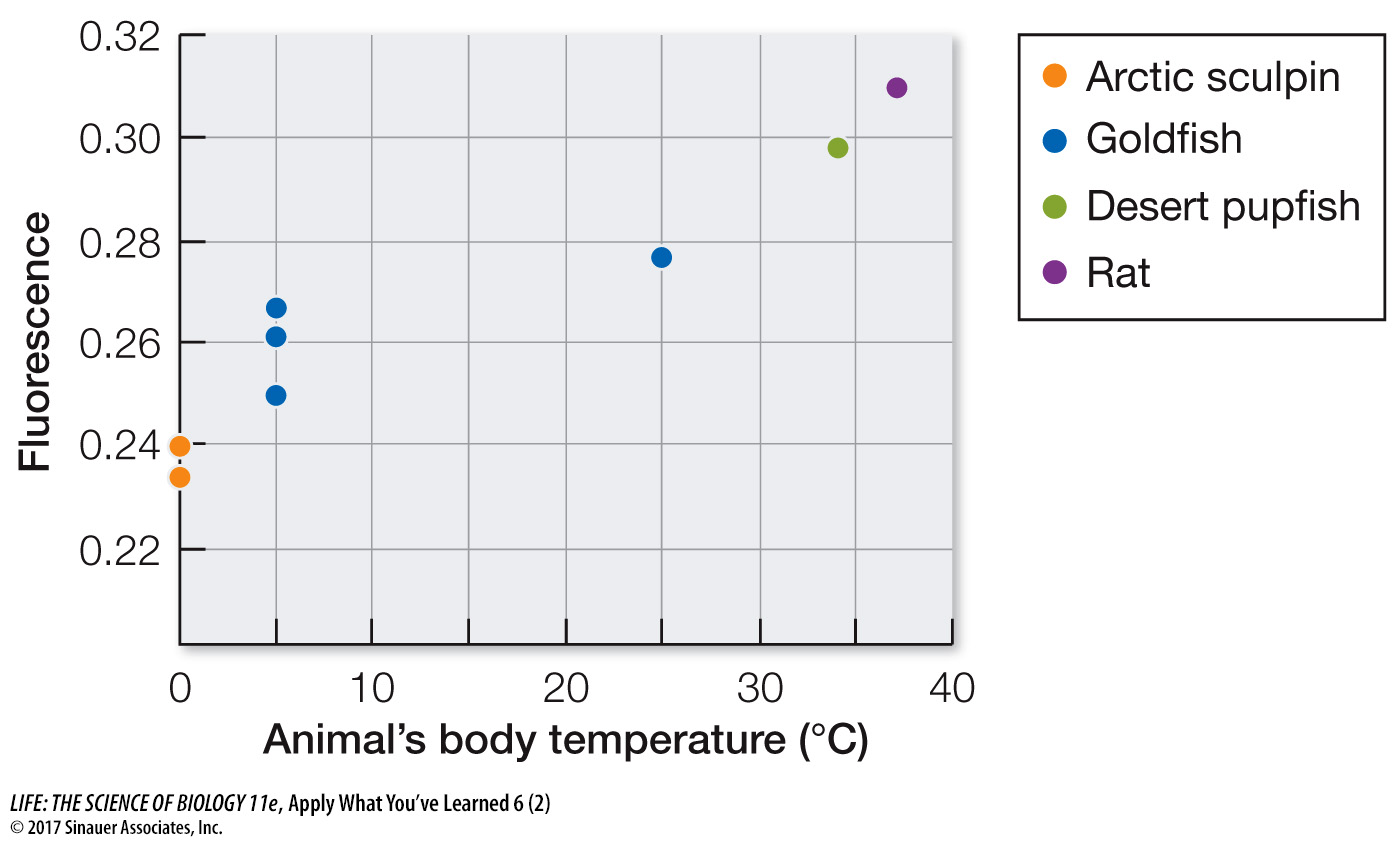Apply What You’ve Learned
Review
6.1
The degree of a membrane’s fluidity is influenced by lipid composition and temperature.
Original Paper: Cossins, A. R. and C. L. Prosser. 1978. Evolutionary adaptation of membranes to temperature. Proceedings of the National Academy of Sciences USA. 75: 2040–
Fish are poikilotherms, animals having body temperatures that change with their environment. Depending on where you go in the world, you can find fish at all extremes of body temperature. Desert pupfish native to desert springs in California and Mexico tolerate temperatures as high as 42°C. At the other extreme is the Arctic sculpin, which can tolerate water temperatures as low as −2°C. Goldfish live at more moderate temperatures ranging from 5°C to 25°C.
A research group saw this range as an interesting opportunity to run a comparative study of the fluidity and composition of cell membranes. They included rats and hamsters in the study, because rats maintain a constant body temperature of 37°C and represent the high end of the temperature range. The researchers kept each animal at a specific temperature for several days. Arctic sculpin were held at 0°C. One group of goldfish was held at 5°C, and another was held at 25°C. Desert pupfish were held at 34°C, and rats were held at normal room temperature, 21°C. The same neuronal cells were removed from each animal and membranes isolated from these cells. This gave the researchers a set of cell membranes representing environmental temperatures ranging from 0°C to 37°C.
The researchers then added a fluorescent molecule to each of the membranes and incubated them at 20°C. They measured fluorescence and plotted these data against the animal’s body temperature, as shown in the graph below. (Each point represents a single animal.) Fluorescence is inversely related to the movement of the molecules within the membranes. A higher value means less movement of the fluorescent probe and therefore a less fluid membrane.
The table below shows the ratio of saturated to unsaturated fatty acids in the phospholipid phosphatidyl choline for various species in the study.
| Ratio of saturated to unsaturated fatty acids | ||||
|---|---|---|---|---|
| Arctic sculpin 0°C | Goldfish 5°C | Goldfish 25°C | Desert pupfish 34°C | Rat 37°C |
| 0.593 | 0.659 | 0.817 | 0.990 | 1.218 |
Questions
1.
What do the data in the graph indicate about the relative fluidity of cell membranes in different species when measured under the same temperature conditions? Is a trend apparent? Explain.
When measured at a constant temperature, the cell membranes show a trend toward greater fluidity with decreasing temperature of a species’ native environment. The least fluid membranes are found in animals that experience the highest temperatures (rats with body temperatures of 37°C). Fluidity is slightly greater in desert pupfish at 34°C and increases even more in goldfish raised at 25°C. This trend continues with increasing fluidity in goldfish raised at 5°C. The greatest fluidity is observed in arctic sculpin raised in extremely cold temperatures (0°C).
2.
Temperature affects membrane fluidity. According to the data, what else influences membrane fluidity?
The data suggest that the ratio of saturated to unsaturated fatty acids in phospholipids making up the membrane also influences its fluidity.
3.
Considering your answer to Question 2, explain how and why this factor affects membrane fluidity.
Saturated fatty acids can pack together more tightly than unsaturated fatty acids, reducing membrane fluidity. Shifting to a greater proportion of unsaturated fatty acids would be appropriate as temperatures decrease, because molecular motion decreases as temperature decreases. At very low temperatures, the membrane needs more unsaturated fatty acids to reduce tight packing and maintain fluidity. At very high temperatures, the membrane can accommodate tight-
4.
Suppose you isolated cell membranes from an animal and measured the fluorescence of a membrane probe in the same way that these researchers did. If the fluorescence was found to be 0.27, and assuming that the movement of the fluorescent probe is only affected by fatty acid saturation/unsaturation, what can you predict about the ratio of saturated to unsaturated fatty acids in ethanolamine phospholipids present in membranes of this animal? Express your answer to the hundredths place.
From the fluorescence value, the graph indicates that the cell membranes of the animal must have been raised at a temperature of about 15°C. This temperature falls between data collected for goldfish at 5°C and 25°C. This means that the ratio of saturated to unsaturated fatty acids in this animal might be expected to fall somewhere between 0.66 and 0.82 based on the data provided in the table, and probably close to 0.70.
